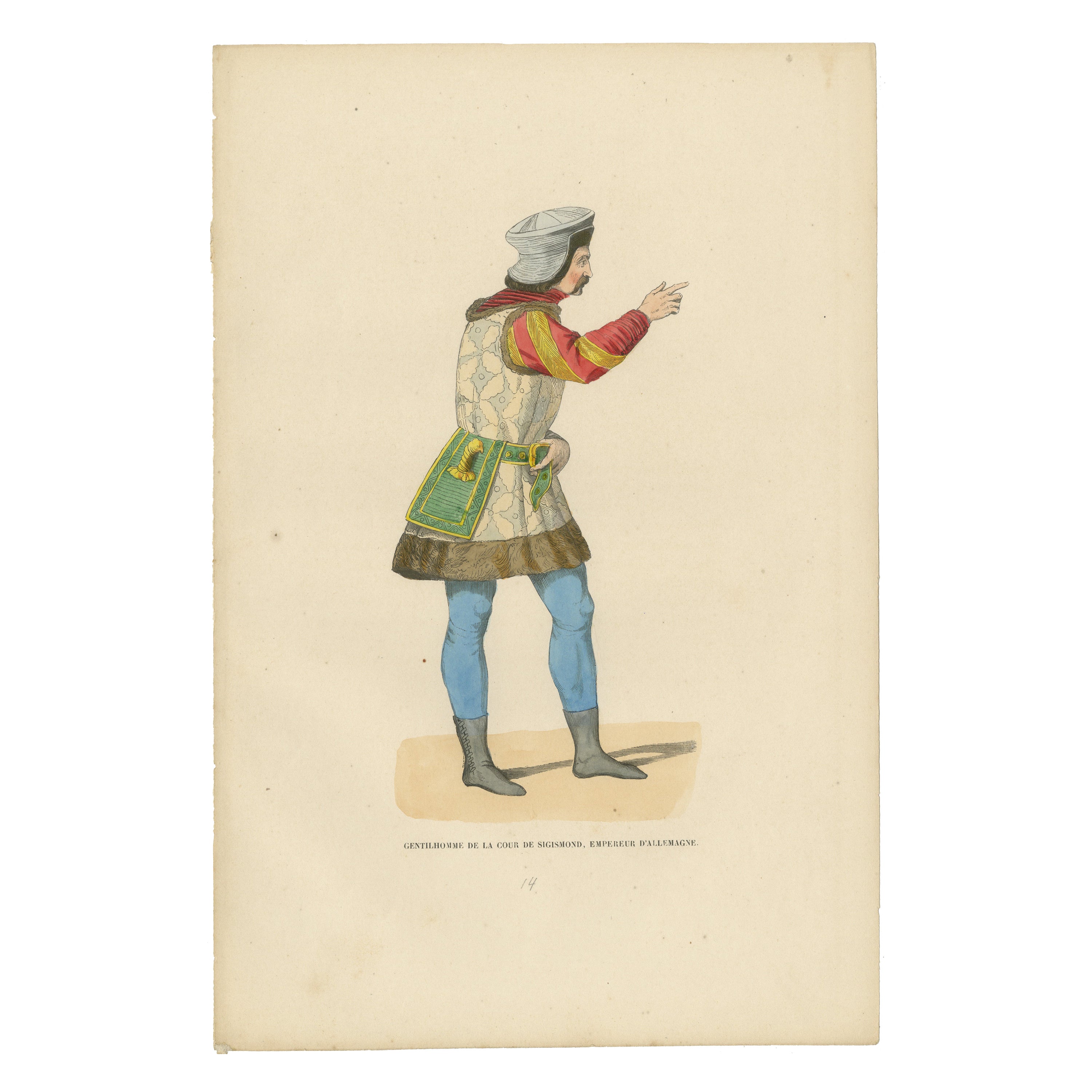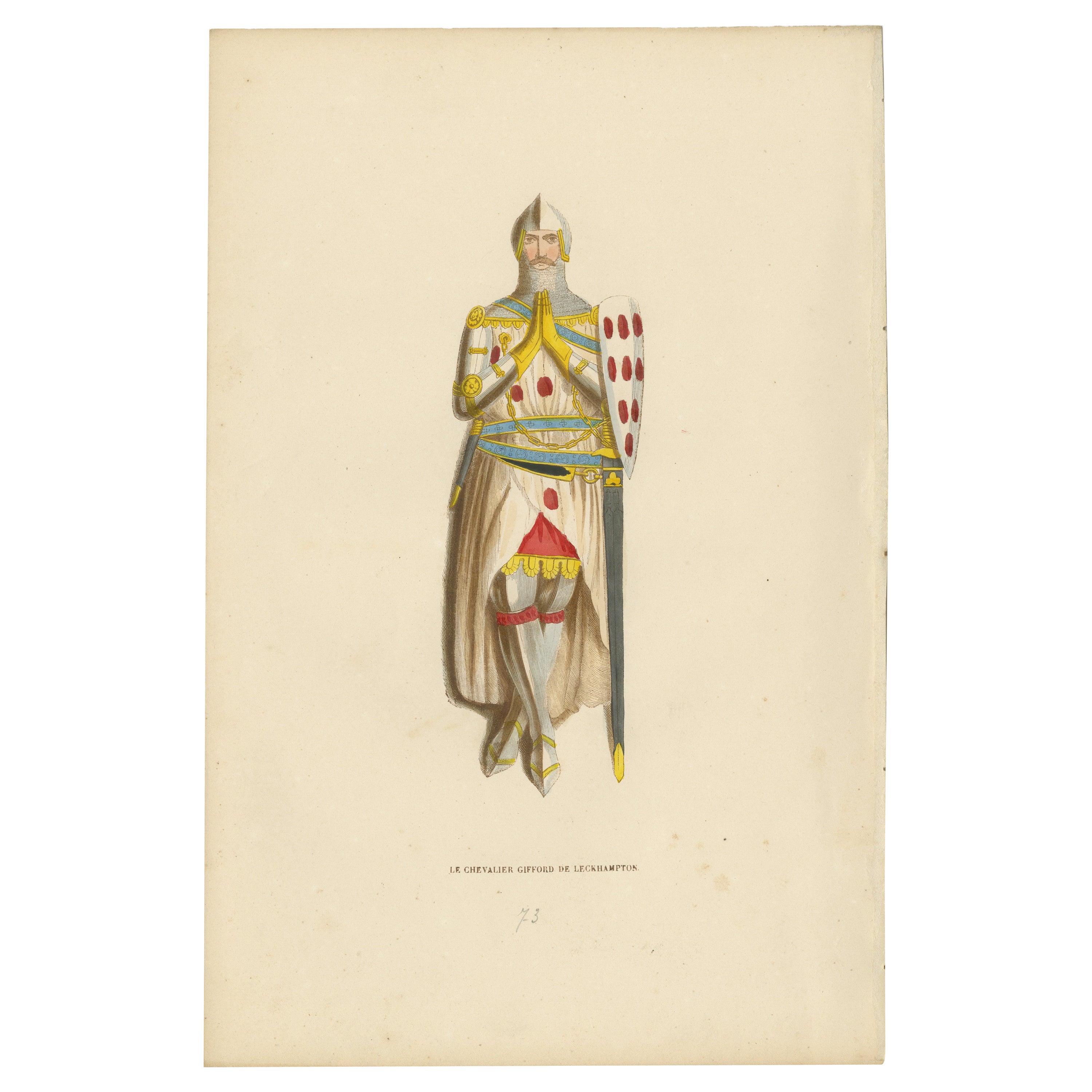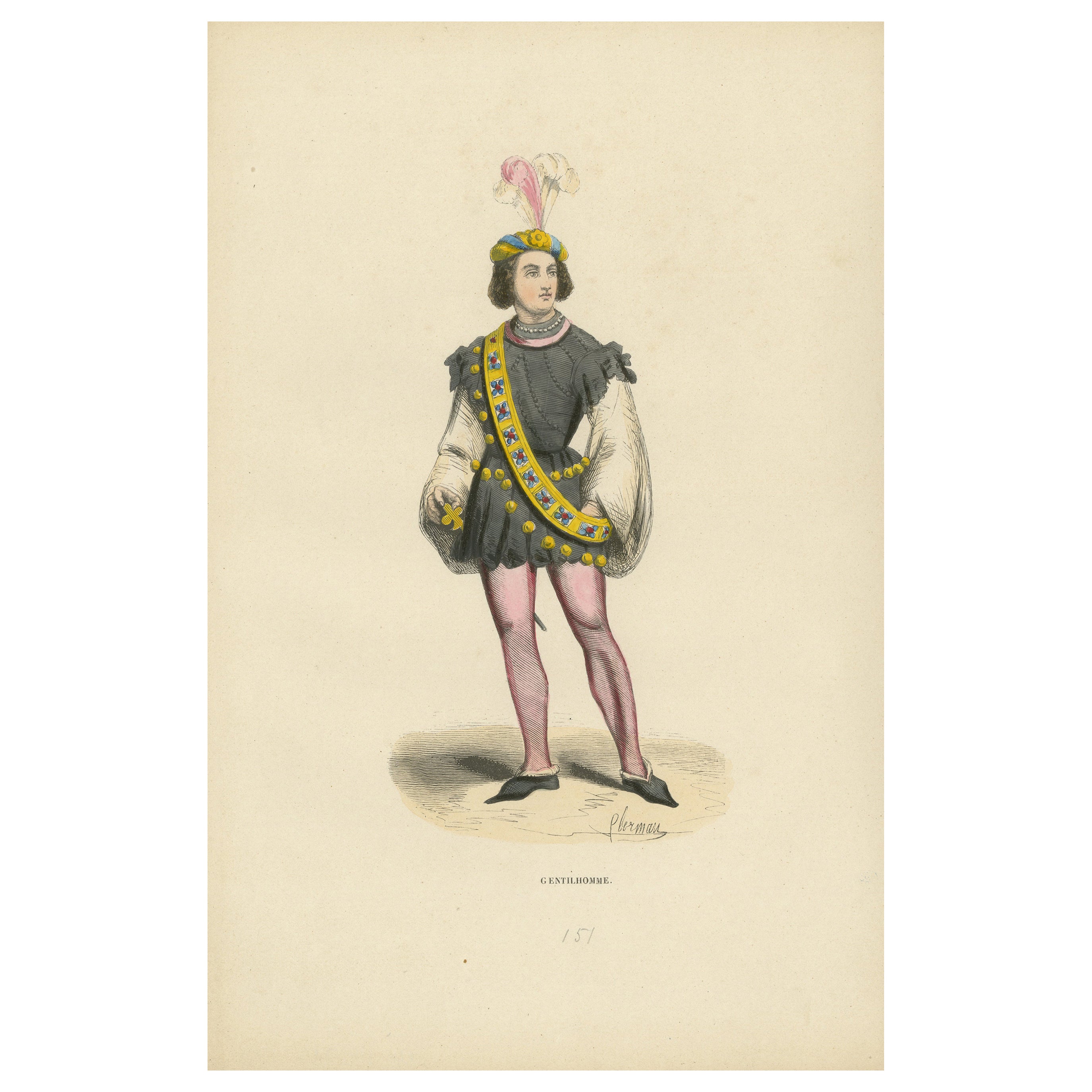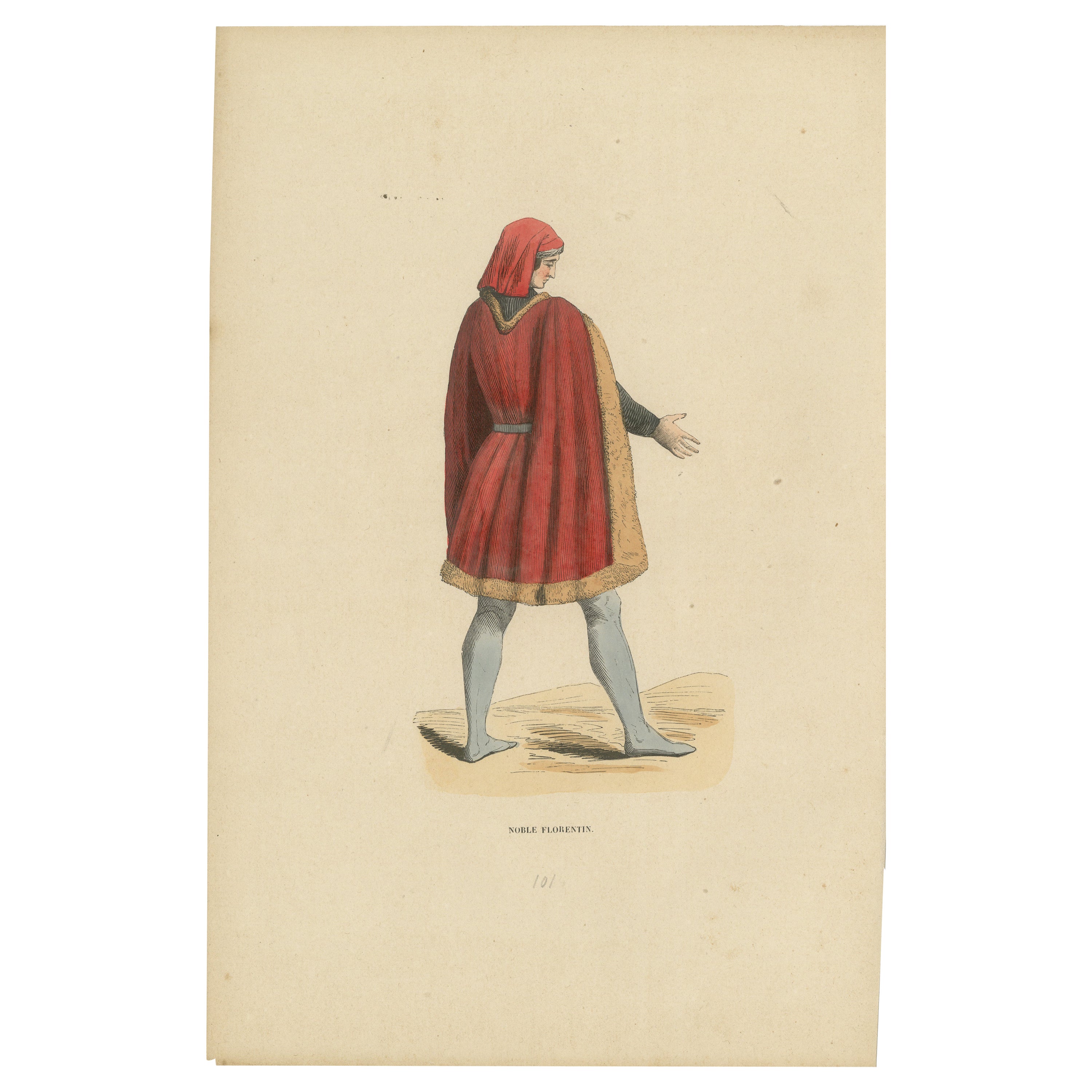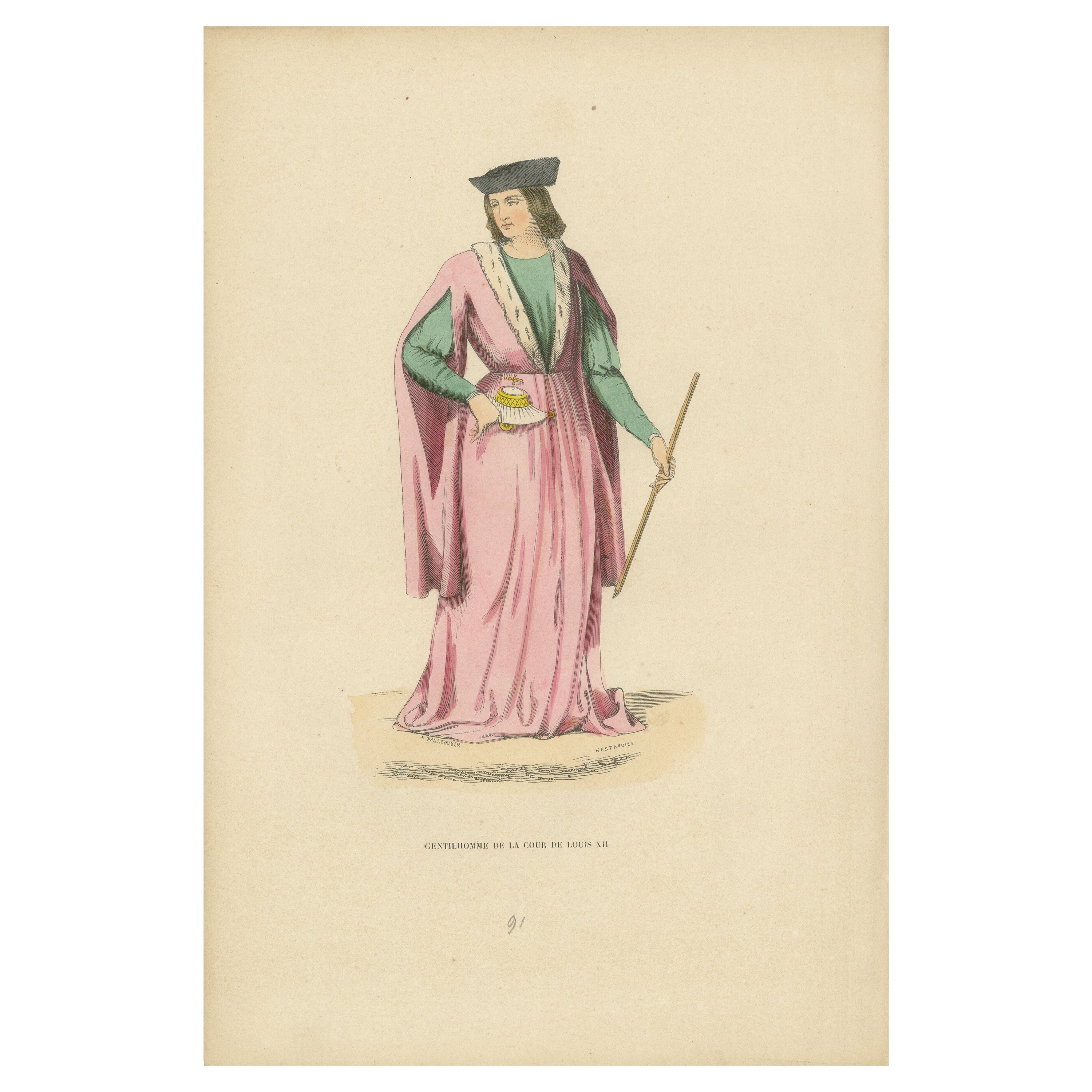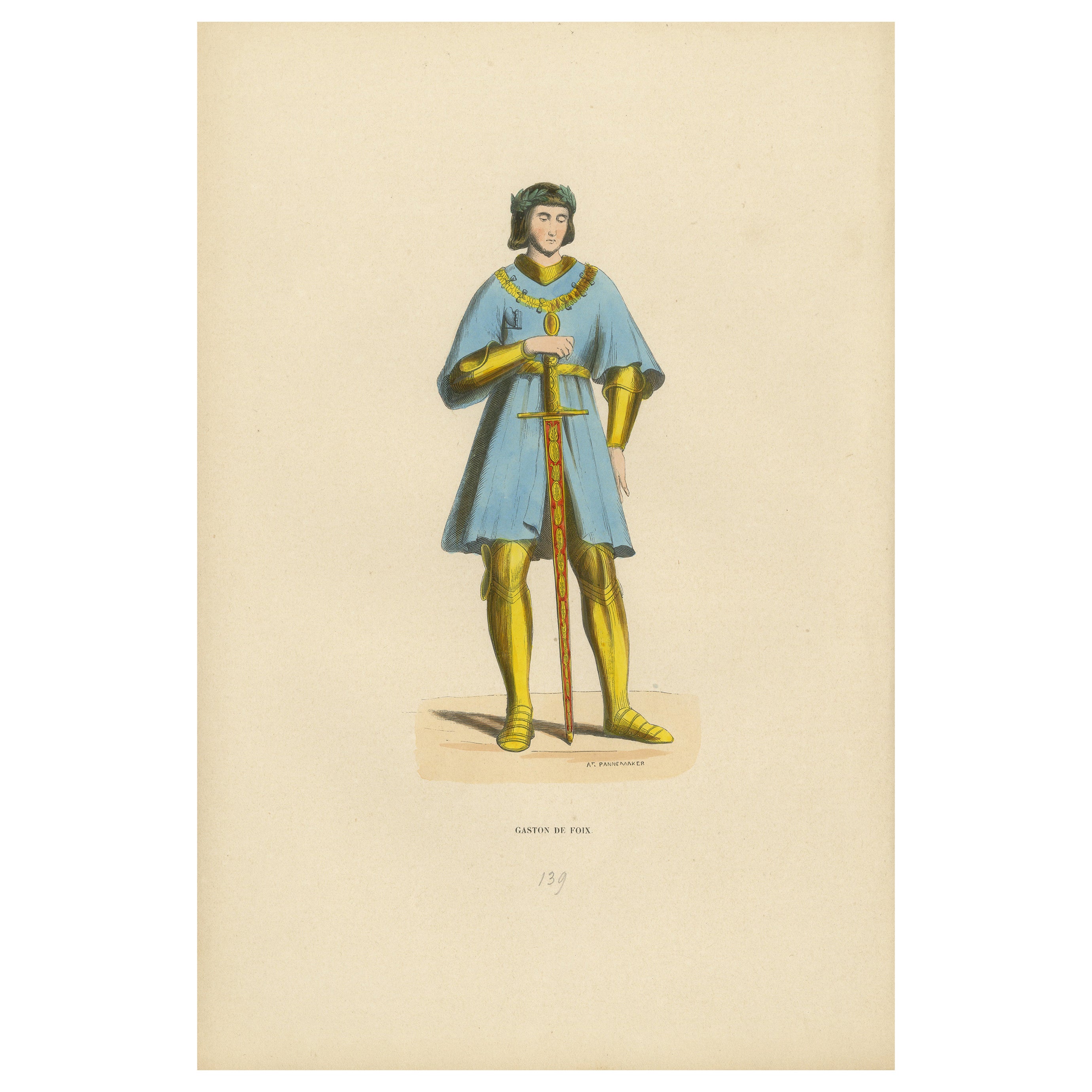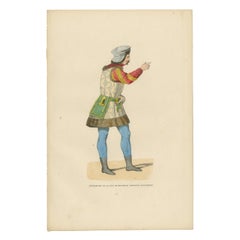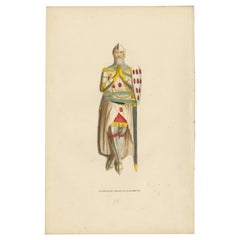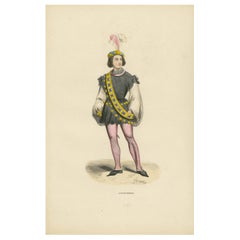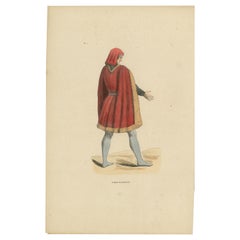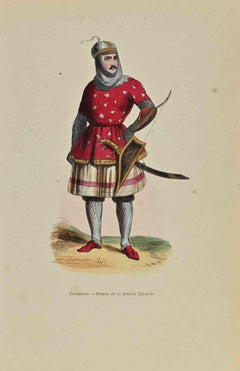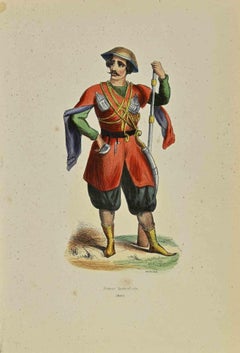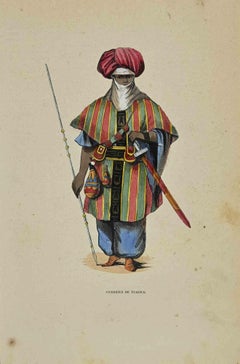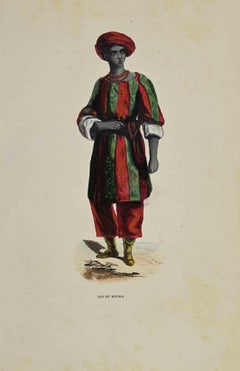Items Similar to Jean de Werchin, a Knight and Seneschal of Hainaut: The Knight's Poise, 1847
Want more images or videos?
Request additional images or videos from the seller
1 of 6
Jean de Werchin, a Knight and Seneschal of Hainaut: The Knight's Poise, 1847
$114.98
$143.7320% Off
£85.21
£106.5120% Off
€96
€12020% Off
CA$156.97
CA$196.2220% Off
A$174.63
A$218.2820% Off
CHF 91.54
CHF 114.4320% Off
MX$2,133.90
MX$2,667.3720% Off
NOK 1,165.67
NOK 1,457.0820% Off
SEK 1,097.31
SEK 1,371.6420% Off
DKK 730.94
DKK 913.6720% Off
Shipping
Retrieving quote...The 1stDibs Promise:
Authenticity Guarantee,
Money-Back Guarantee,
24-Hour Cancellation
About the Item
Title: "Jean de Werchin: The Knight's Poise"
Description: This print illustrates Jean de Werchin, a knight and seneschal of Hainaut, captured in a moment of courtly grace. His posture is relaxed yet dignified, suggesting a knight who is as comfortable in the court as on the battlefield.
He is dressed in a long tunic or robe that reaches down to his feet, patterned with a floral or rose motif, possibly indicative of a personal symbol or the emblem of a chivalric order. The tunic is in a pale shade, overlaid with a blue garment edged in gold, which adds a regal touch to his attire. The blue garment is secured at the waist with a golden belt, accentuating the knight's stature.
Over his attire, he wears a cape or cloak that displays a continuation of the floral pattern, with a fur trim suggesting wealth and status. The cloak's lining is visible at the collar, providing a contrast with the outer pattern and adding depth to the ensemble.
Jean de Werchin's head is adorned with a red chaperon, a type of headwear popular in the Middle Ages, with a prominent rolled edge giving it a distinctive profile. His hair is cut in a style typical of the nobility of the time.
His right hand holds a slender rod or staff, perhaps a symbol of his office as seneschal, while his left hand is extended outward in a gesture that might be part of a formal address or conversation.
The print captures a sense of the refined elegance that knights like Jean de Werchin would have brought to their roles as both warriors and members of the noble class. His apparel and demeanor are fitting for a man of his rank, reflecting the chivalric ideals of leadership, honor, and service that characterized the medieval nobility.
The colors have a nice glow over them. Historically, egg whites, known as glair, and sometimes egg yolk were indeed used in illumination and painting, particularly in manuscripts, to give colors a brighter appearance and to add a sheen or gloss to the work. This technique was quite common during the Middle Ages and into the Renaissance.
Egg whites can be applied as a varnish over pigments to enhance their brightness and to protect the colors. This application could make the colors appear more vivid and also add a slight glossy sheen to the surface of the image.
Egg yolk, on the other hand, was commonly used as a binding agent in paint. It forms the basis of tempera paint, a medium that was widely used before the advent of oil painting. Egg yolk helps to create a durable and long-lasting color that adheres well to various surfaces.
In the context of the print from 1847, it's less likely that egg whites or yolks were used directly on the print, as by that time, commercial printing processes would have been more advanced and less reliant on such manual methods. However, if this print is a representation of an earlier style or is meant to mimic the appearance of hand-painted manuscripts, the original artists might have employed techniques or materials that gave a similar effect to those achieved with egg-based binders and varnishes.
- Dimensions:Height: 10.63 in (27 cm)Width: 7.09 in (18 cm)Depth: 0 in (0.02 mm)
- Materials and Techniques:
- Period:
- Date of Manufacture:1847
- Condition:Good. Overal light toning and light soiling but the image itself clean and hand-colored almost 200 years ago and still in expliciet colors. Aged paper with typically warm, yellowish-brown hue, mostly around the edges. Study the image carefully.
- Seller Location:Langweer, NL
- Reference Number:Seller: BG-13635-491stDibs: LU3054337894802
About the Seller
5.0
Recognized Seller
These prestigious sellers are industry leaders and represent the highest echelon for item quality and design.
Platinum Seller
Premium sellers with a 4.7+ rating and 24-hour response times
Established in 2009
1stDibs seller since 2017
2,502 sales on 1stDibs
Typical response time: <1 hour
- ShippingRetrieving quote...Shipping from: Langweer, Netherlands
- Return Policy
Authenticity Guarantee
In the unlikely event there’s an issue with an item’s authenticity, contact us within 1 year for a full refund. DetailsMoney-Back Guarantee
If your item is not as described, is damaged in transit, or does not arrive, contact us within 7 days for a full refund. Details24-Hour Cancellation
You have a 24-hour grace period in which to reconsider your purchase, with no questions asked.Vetted Professional Sellers
Our world-class sellers must adhere to strict standards for service and quality, maintaining the integrity of our listings.Price-Match Guarantee
If you find that a seller listed the same item for a lower price elsewhere, we’ll match it.Trusted Global Delivery
Our best-in-class carrier network provides specialized shipping options worldwide, including custom delivery.More From This Seller
View AllCourtly Splendor: A Nobleman at Emperor Sigismund's Court, 1847
Located in Langweer, NL
The image depicts a man identified as a "Gentilhomme de la cour de Sigismond, empereur d'Allemagne," which translates to "Gentleman of the court of Sigismund, Emperor of Germany."
This individual is portrayed in a profile stance, dressed in attire that is indicative of the high-status courtiers during the time of Emperor Sigismund, who reigned in the early 15th century. He is wearing a turban-like headgear, which reflects the influence of Eastern fashion on European court attire, possibly due to the Ottoman influence or the general exchange of culture during the Crusades and subsequent interactions.
His doublet is richly patterned and he has puffed sleeves in red, which were fashionable among the nobility during the period. The garment is accented with a decorative belt that holds what appears to be a purse or a pouch. He also sports tight blue hose and pointed shoes, which complete the ensemble typical of a nobleman or a high-ranking court official in the Holy Roman Empire.
Egg whites can be applied as a varnish over pigments to enhance their brightness and to protect the colors. This application could make the colors appear more vivid and also add a slight glossy sheen to the surface of the image.
Egg yolk, on the other hand, was commonly used as a binding agent in paint. It forms the basis of tempera paint, a medium that was widely used before the advent of oil painting. Egg yolk helps to create a durable and long-lasting color that adheres well to various surfaces.
In the context of the print from 1847, it's less likely that egg whites or yolks were used directly on the print, as by that time, commercial printing processes would have been more advanced and less reliant on such manual methods. However, if this print is a representation of an earlier style or is meant to mimic the appearance of hand-painted manuscripts...
Category
Antique 1840s Prints
Materials
Paper
$153 Sale Price
20% Off
Engraving of Le Chevalier Gifford de Léchampton: The Gallant Knight, 1847
Located in Langweer, NL
Title: "Le Chevalier Gifford de Léchampton: The Gallant Knight"
Description: This print portrays the knight Gifford de Léchampton in full regalia, stand...
Category
Antique 1840s Prints
Materials
Paper
$229 Sale Price
20% Off
The Gallant Courtier: A Nobleman's Fashion in 'Costume du Moyen Âge, 1847
Located in Langweer, NL
Title: "The Gallant Courtier: A Nobleman's Fashion in 'Costume du Moyen Âge'"
Description: This 1847 lithograph from the "Costume du Moyen Âge" collection depicts a nobleman dressed...
Category
Antique 1840s Prints
Materials
Paper
$134 Sale Price
20% Off
Florentine Nobleman of the Middle Ages, 1847
Located in Langweer, NL
Title: "Civilian Costume at the End of the 15th Century"
Description: The image is a print from a series the "Costume du Moyen Age" dated 1847, and titled "Costume Civil de la Fin du XVe Siècle," which translates to "Civilian Costume at the End of the 15th Century." It showcases a man of status, possibly a noble or a wealthy burgher, standing in a poised and confident manner.
He is attired in an ornate cloak covered in a complex pattern of fleur-de-lis and cross motifs, indicative of wealth and possibly a connection to royalty or high social rank. The cloak is open at the front to reveal a blue doublet with a belt, and he wears red hose—a fashion staple of the late medieval period. His footwear is also red, which stands out against the more subdued tones of his outfit.
On his head, he sports a fur-trimmed hat, adding to the luxuriousness of his attire. In one hand, he holds a long staff, which serves as both a walking aid and a symbol of authority. His other hand rests on the hilt of a dagger, further indicating his readiness to defend his status or engage in the political or civic matters of his time.
The artist has skillfully rendered the textiles and accessories with great care, emphasizing the fashion and social cues of the late 15th-century European society.
The colors have a nice glow over them. Historically, egg whites, known as glair, and sometimes egg yolk were indeed used in illumination and painting, particularly in manuscripts, to give colors a brighter appearance and to add a sheen or gloss to the work. This technique was quite common during the Middle Ages...
Category
Antique 1840s Prints
Materials
Paper
$124 Sale Price
20% Off
Elegance at the Court of Louis XII: A French Noble's Poise, 1847
Located in Langweer, NL
Title: "Elegance at the Court of Louis XII: A French Noble's Poise"
Description: This delicate historical illustration depicts a French nobleman from the court of King Louis XII, elegantly attired in the fashion of the early 16th century. He stands with a composed and dignified stance, a walking stick in one hand, exuding the grace and refinement expected of someone from his esteemed position.
His attire is a rich blend of colors and textures, indicative of his status. The nobleman wears a soft pink tunic, a color that during the time was often associated with nobility due to the expense of the dye required to produce it. The tunic is complemented by a deep green overcoat...
Category
Antique 1840s Prints
Materials
Paper
$134 Sale Price
20% Off
Noble Bearing: Gaston de Foix as Illustrated in 'Costume du Moyen Âge', 1847
Located in Langweer, NL
Title: "Noble Bearing: Gaston de Foix as Illustrated in 'Costume du Moyen Âge'"
Description: The lithograph from "Costume du Moyen Âge," created in 1847, features a depiction of Gas...
Category
Antique 1840s Prints
Materials
Paper
$162 Sale Price
20% Off
You May Also Like
Circus, Prince of the Great Cabarde - Lithograph by Auguste Wahlen - 1844
Located in Roma, IT
Circus, Prince of the Great Cabarde is a lithograph made by Auguste Wahlen in 1844.
Hand colored.
Good condition.
At the center of the artwork is the original title "Circassien , ...
Category
1840s Modern Figurative Prints
Materials
Lithograph
Imerethian Prince - Lithograph by Auguste Wahlen - 1844
Located in Roma, IT
Imerethian Prince is a lithograph made by Auguste Wahlen in 1844.
Hand colored.
Good condition.
At the center of the artwork is the original title "Imerethian Prince".
The work i...
Category
1840s Modern Figurative Prints
Materials
Lithograph
Guerrier de Tuarick - Lithograph by Auguste Wahlen - 1844
Located in Roma, IT
Guerrier de Tuarick is a hand colored lithographs realized by Auguste Wahlen in 1844.
Good conditions.
Ghe artwork belongs to the Suite Moeurs, usages et costumes de tous les peupl...
Category
1840s Modern Figurative Prints
Materials
Lithograph
Roi de Boussa - Lithograph by Auguste Wahlen - 1844
Located in Roma, IT
Roi de Boussa is a hand colored lithographs realized by Auguste Wahlen in 1844.
Good conditions.
The artwork belongs to the Suite Moeurs, usages et costumes de tous les peuples du ...
Category
1840s Modern Figurative Prints
Materials
Lithograph
Circassian - Lithograph by Auguste Wahlen - 1844
Located in Roma, IT
Circassian is a lithograph made by Auguste Wahlen in 1844.
Hand colored.
Good condition.
At the center of the artwork is the original title "Circassien".
The work is part of Suit...
Category
1840s Modern Figurative Prints
Materials
Lithograph
Cavalier - Hand-Colored Lithograph - 19th Century
Located in Roma, IT
Cavalier is an original hand-colored lithograph on paper realized by an Anonymous artist of the XIX century, it represents a cavalier in his particular costume with shield through ha...
Category
19th Century Modern Portrait Prints
Materials
Lithograph
More Ways To Browse
Knight Antique
Fur Trim Dress
Red Rose Print Dress
Antique Glass Powder Boxes
Antique Horse Wagon
Antique Hunting Accessories
Antique Hunting Pack
Antique Metal Rooster
Antique Metal Tea Pot
Antique Necessaire
Antique Pie Case
Antique Pill Box Gold
Antique Sake Set
Antique Silver Boxes Repousse
Antique Storm Glass
Antique Thimbles
Antique Victorian Grandfather Clock
Antique Wooden Swan
